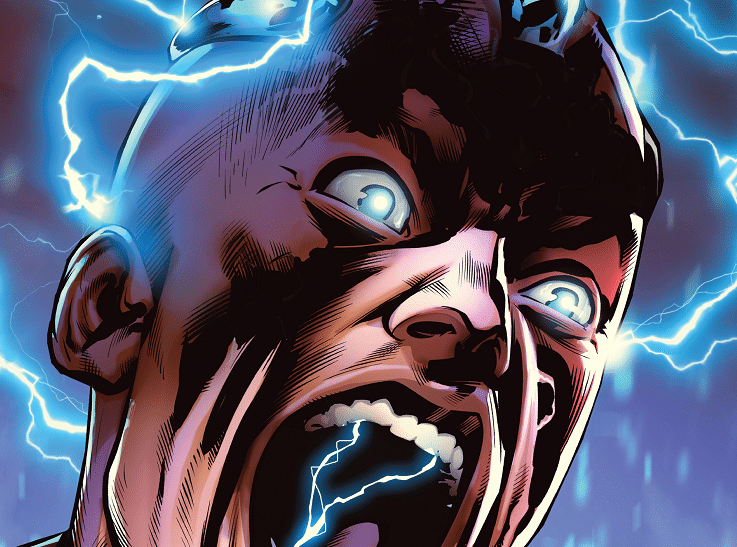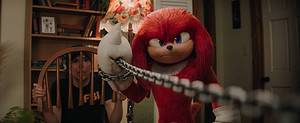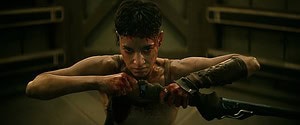[vc_row][vc_column][vc_images_carousel images=”27325,27326″ img_size=”411×624″ speed=”3000″ autoplay=”yes” wrap=”yes”][vc_column_text]
‘In a future where technology is illegal, a war is brewing between the Augmented, who have chosen to integrate technology into their bodies, and the Authentic, who have not. The resistance movement, Neon Future, strives to bring peace by showing the world a brighter future in harmony with technology.’ – NEON FUTURE
I’m often asked what it I like the most about entertainment conventions. Is it the parties? The cosplay? The panels? The announcements?
Sure, all of those things are great but what I love the most is having the opportunity to meet amazing people. So when the chance came up to meet Tom Bilyeu AKA the entrepreneur extraordinaire, noted public speaker, and now CEO of the entertainment company known as Impact Theory I jumped at the chance.
If you check out Tom Bilyeu’s bio on the Impact Theory website and how he describes himself you’ll begin to understand why he stands out.
‘I’m a relentless agent for change, here to see how far I can push my own potential and the potential of others. I used to think I was Morpheus or Neo, now I know I’m the White Rabbit. My job is to simply show you how deep the rabbit hole really goes. The rest will be up to you.’
Tom Bilyeu followed the not so traditional path to success. He started up the mega successful Quest Nutrition (the company famous for their Quest Bars sold pretty much everywhere), sold it, and then when on to start what I predict to be a very significant, as well as successful, entertainment company called Impact Theory.And one of their offerings is a story that gives us a great look into a possible not so distant future, the comic book series known as Neon Future. (The trade paperback vol 1 (issues 1-6) comes out on Oct 2nd, 2019).
I had the chance at San Diego Comic Con to talk to Tom about his background as a successful entrepreneur, what his solution is to fixing the comic book industry, and which character is based off of him in the Neon Future comic book series.
JG (James Gavsie): So the first question I have is what made you go from serial entrepreneur, to starting and then selling Quest Nutrition to creating Impact Theory and launching a comic book series like Neon Future?
TB (Tom Bilyeu): Let’s go back a little bit. I graduated from film school and I thought I would get a three picture deal and be off to the races. And of course it wasn’t quite how it worked out and I was very frustrated and I had no idea how to be successful. And I met these two entrepreneurs who said If you want to control the art, you have to control the resources. So why don’t you come with us and get rich.
JG: Wow!
TB: I remember thinking that that sounds amazing and that it should take about 18 months. I’m ready to go. And…it took 15 years, but it actually worked and we started multiple companies together. Finally culminating in Quest Nutrition, which we built from nothing to being valued at over a billion dollars in five years. I was there for about seven total years, exited that about two and a half years ago because I finally had the capital to start my own studio.
JG: So having your own studio was the ultimate goal?
TB: Right. Originally, I just wanted to tell stories to facilitate storytelling, but in that 15 year journey, I had to transform myself so much. I realized that it doesn’t matter who you are today it just matters who you want to become and the price you’re willing to pay to get there. And I find that people for the most part aren’t willing to pay that price, but they could if they understood the mind better.
JG: That’s a great observation.
TB: I think the one thing I’ve gotten extraordinarily good at as an entrepreneur is really being able to identify what is true and then changing in accordance with that. And so the comic industry is just so fundamentally broken and nobody inside the business seems to be trying to fix it. And so when you come in from the outside, it’s so patently obvious what is wrong that you can sometimes just bring that knowledge from outside the industry with a potential solution.
JG: That’s really interesting. I have talked with so many different writers, editors, and publishers from the various comic book companies and they have mirrored what you’ve said. And everyone seems to have a different opinion on how to fix things. So, in your opinion what is the fix to this problem?
TB: The solution is purely one of business realities. And if you go to Tokyo and you see how thriving the comic book market is there. There are comic book shops in every neighborhood. In the U.S. what do we have? Something like less than 3000 shops. So you look at Tokyo and there’s hundreds of comic book stores in one city, hundreds! Sometimes in the 90s the comic book industry changed for various reasons. So what happened is you have almost two generations of people that were not trained to go buy comics.
So how do we get new people in the comic buying ecosystem? The easiest way to get somebody new is to go young.
JG: Hold on. Tell me more about the comic book industry in Japan.
TB: Here’s the big difference. Comic books are sold in book format.
JG: You’re talking about the Manga format?
TB: Right. Now why that’s interesting to me is when you look at the Japanese market, ask yourself why is it thriving? Part of it is that comics are sold in book format which just makes things easier. It’s an impulse buy. You can walk in and say I’ll try this. I’ll try that knowing I don’t have to commit to like dribs and drabs over the next six months and I’d probably miss one and then I’d go in and it’s sold out. It’s like I’m getting this, it’s done. Complete story, so whether I read it now or six months from now when I have it, I’m never going to get lost. Which is exactly what happens to many people in the U.S. who collect one issue at a time. And that’s why I have a 25 year plan on how to fix the market.
JG: Really?
TB: Absolutely. It really won’t even take that long since it’s a generational solution. You’ve got to raise kids on comics. There’s no way around it.
JG: Somehow I’m not surprised that you’ve got a 25 year plan. You’ve mentioned that you see comic books as a great form of teaching aid. What is the message you’re giving with Neon Future?
TB: What we’re trying to do is help people empower themselves. We want you to feel like you’re capable of more at the end of the story than you did at the beginning. So whether our hero heroes succeeds, whether they fail, whether they’re noble in their ignorance, none of that matters. What matters is do you as the reader feel like you can do more with your life at the end of it than you did at the beginning? And with Neon Future I feel we’re doing that.
JG: Issue #1 really grabbed me. It’s really interesting how you took that world’s ultimate villain (Clay, a regular human who is anti-tech augmentation within humans) and turned him into the hero for the cause of human and technology integration! How many people would think to make a Lex Luthor the hero of the story?
TB: Well, we want to be counterintuitive. We want to be surprising, we want to challenge ourselves as writers. And so a big thing for me with that journey that I want to take people on is that most people start in some very dark place that is embedded with self hatred. And so I wanted to start with the character you’d look at and think that he really isn’t capable. And then watch and witness how it is possible even for somebody like that to rise. So to start with a person that is from our side that we’re rooting for, you know, the augmented side for it to be the very person they hate the most. And that was partly born out of Nelson Mandela’s long walk to freedom. And I wanted to make Clay, the hero, the least likely candidate to be saved by this revolutionary group within the (technologically) Augmented community. But what made Nelson Mandela so beautiful was that he believed we all have to come together.
JG: Can you explain that?
TB: Sure. Neon Future is not a story about someone becoming the oppressor. This is because there are three ways to deal with oppression; remain oppressed, become the oppressor, or find the third way of bringing people together. And so we wanted the book to explore the third Way. So to do that most effectively, you have to have flip sides. So that’s the issue for Clay within the story. All of a sudden a normal human who hates his augmented tech given to him starts to really like what he can do with his augmentation.
JG: That was in Issue #4 which was a phenomenal part of the story. So are there levels of technical ability and transformation through augmentation within the Neon Future world?
TB: Right.
JG: Was that part of the message? As in ‘Hey, if you enjoy yourself through this journey and you enjoy where you are at level one imagine how great things are going to be at level four or level five?
TB: So what Clay is learning to do now, you will see is, is a very small part where he’s ultimately going to go with his capabilities. And the small amount of power he’s unlocked will provide part of the inspiration for him to continue to explore his potential.
And there’s an arc to that part of what we’re going to deal with which is called the false growth.
JG: False growth?
TB: Where a character believes they’re more of a badass than they really are. And they learn that the hard way.
JG: So what side would you be on within Neon Future?. If you were to put yourself in this story who would you be? Are you augmented with tech or not?
TB: That is the easiest question. Okay. If I die and I’m not assigned or given some type of tech I will be really disappointed. There are people that kind of already control exoskeletons with their mind. I won’t be an early adopter because I think that’s super dangerous, but I will be open to every opportunity if there is a way to improve myself for technology that is safe.
JG: There are a lot of interesting characters throughout Neon Future. So who are you in this story?
TB: Oh, very, very transparently I’m Clay.
JG: Wait, you are Clay? The Clay who starts off as the biggest villain to the story and then goes on a journey to become the hero?
TB: Yes, really. Clay not only essentially represents my voice and my sense of humor, but the terrifying emotional journey that I had to go on to become who I am.
JG: So reading through the issues of Neon Future, and again going through your bio, one question came to mind. If you, Tom Bilyeu, could live indefinitely through the use of tech would you do it? Or would you live to something like a thousand years and feel like you’d lived enough?
TB: . I literally do not understand that question.
JG: Really?
TB: I was on the Joe Rogan show and he asked me the same question. So, yes definitely, I would want to live forever. Unless you’re in a state of perpetual suffering, I don’t know why you would ever want to tap out. So for me it’s, there’s this incredible book called Einstein’s Dreams and in it they explore all these different things to do with time. And one of them is a world where everyone lives forever and the world bifurcates into two kinds of people. One Who never does anything and thinks there’s always time to do it tomorrow. And then one that always does everything because you can get good at everything. And living forever would work great with my 70 year plan.
JG: Again, not surprising that you have a 70 year plan!
TB: When I say I have a 70 year plan, it’s almost a thought exercise to make sure that I have a level of clarity that I need. I know that the odds of me living 70 more years are pretty slim but I have a strong desire to play the game and to see where the world goes. Neon Future gives a glimpse of what I think that not-too distant world will look like and what challenges that world will face.
Neon Future is available at comics.impacttheory.com/
Written by James Gavsie
Producer and Host of the Who Would Win Show
Twitter and Instagram – @jamesgavsie[/vc_column_text][/vc_column][/vc_row]








